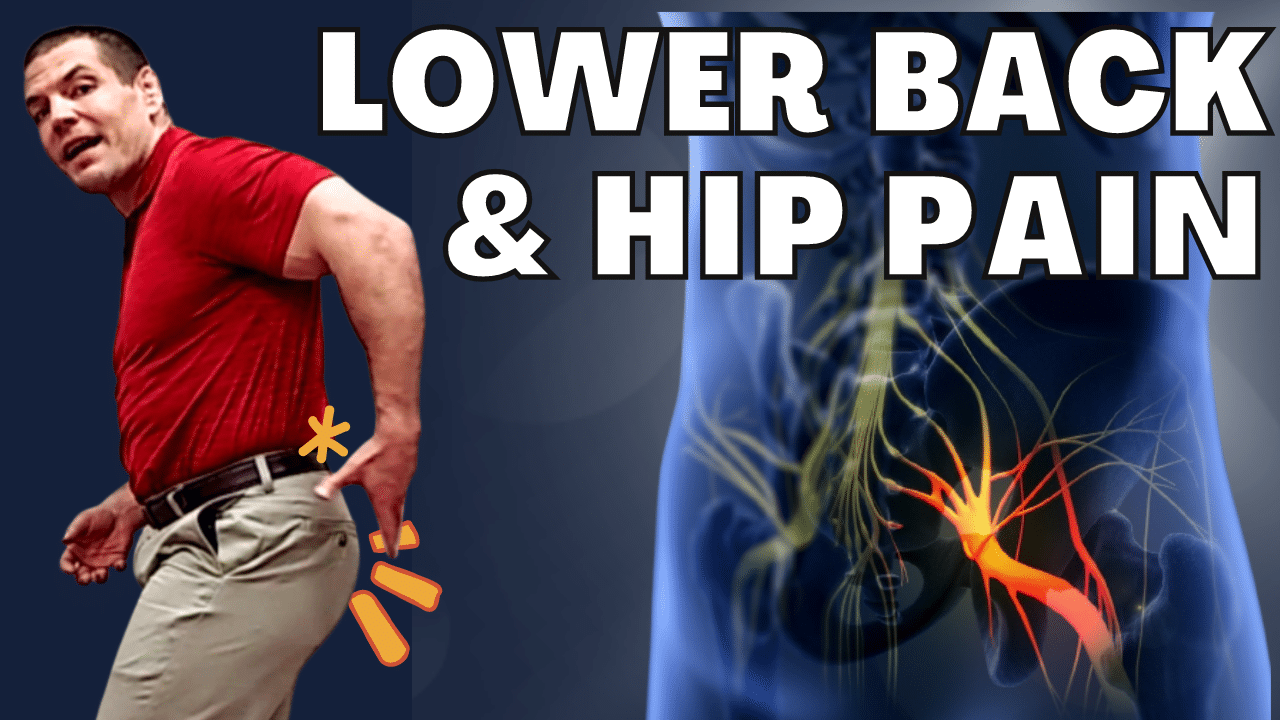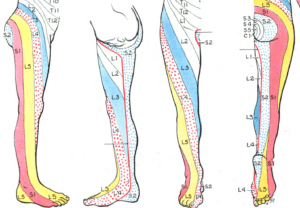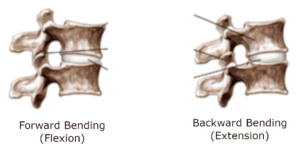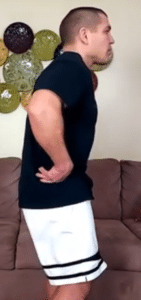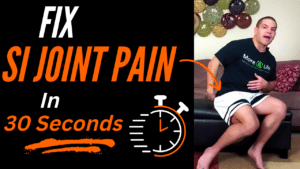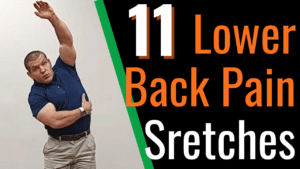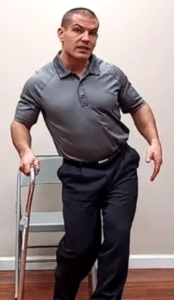If you have radiating lower back pain to your hip, you may wonder what's causing it and what you can do to get it to go away. Watch the video to learn 5 causes of lower back pain that radiates to your hip, plus tips that you can use to relieve it.
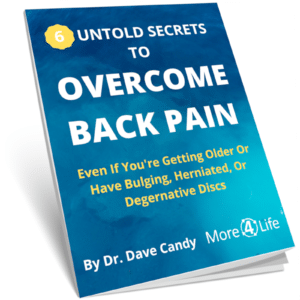
What Causes Radiating Lower Back Pain to the Hip?
There are several things that can cause radiating lower back pain to the hip. Here are the causes that I'll cover in this post:
- Lower Back Facet Joint Pain
- Sacroiliac (SI) Joint Lower Back Pain to Hip
- Lower Back Muscles That Refer Pain to Hip
- Pinched Nerve in the Lower Back Causing Pain into the Hip
- Mixed Patterns of Lower Back Pain and Hip Pain
Additonally, I'll cover tips to help each one of these causes.
- Tips to Help Lower Back Facet Joint Pain
- Tips to Relieve SI Joint Pain
- How to Relieve Lower Back Muscle Pain
- Treatment for Pinched Nerves
- What to Do for Mixed Patterns of Lower Back and Hip Pain
Lower Back Facet Joint Pain
What's the most common cause of radiating lower back pain that goes into your hip?
Well, the most common cause that I see in my clinical practice is actually from the joints in your lower back.
There are little joints that lie on each side of the spine at each spinal level called facet joints.
When you bend backward, it jams the facet joints on both sides of the spine together.
If you bend sideways, it jams the facet joints together on the side that you bend toward.
If you bend backward and sideways at the same time, it can really jam the joints together.
Therefore, it's a good idea to avoid end-range backward bending positions.
This is especially when your spine is under load. For example, let's say you're squatting with a barbell across your shoulders and you have a lot of arch in your back. That can really jam the joints in your lower back together.
Now, the facet joints, particularly the L4, L5, and S1 facet joints tend to radiate lower back pain to the hip.
Therefore, if you're getting lower back pain that radiates into your hip and doesn't go down the leg, then the most likely cause of it is a facet joint dysfunction.
Sacroiliac (SI) Joint Lower Back Pain to Hip
The second cause of lower back pain that radiates into the hip is an SI joint dysfunction.
Your SI joint or sacroiliac joint is where the two sides of your pelvis join with the spine. There's a joint between the ilium either side of the sacrum.
Your SI joint can hurt because it's too stiff (hypomobile) or because it's too mobile (hypermobile).
In many cases, there's some underlying hypermobility or excessive mobility in SI joint dysfunctions.
For example, if you fall on your buttock, you may get the SI joint jammed up.
However, once you unlock it, those ligaments have been sprained or strained.
Therefore, there may be some excessive mobility there.
Likewise, women who are pregnant or have recently been pregnant have extra stretchy ligaments in their pelvis.
The hypermobility in their SI joints makes them prone to locking up at times.
So, if you have an SI joint dysfunction, then you first want to decide if it's a hypermobility problem, meaning it moves too much, or if it's stuck.
That's the second cause of lower back pain that radiates down into your buttock.
Lower Back Muscles That Refer Pain to Hip
The third cause is actually from the muscles in your lower back themselves.
Many people don't know that muscles in your lower back can cause refer pain to your hip.
Trigger Point Wall Chart - Buy On Amazon
Certain muscles refer lower back to the hip and buttock as shown above. Some examples of these are your multifidus, quadratus lumborum, and iliopsoas among others.
Therefore, if you have localized buttock and hip pain along with lower back pain, your lower back muscles be involved.
Now, keep in mind that these things don't happen in isolation.
It doesn't have to just be a facet joint dysfunction, a muscle dysfunction, or an SI joint dysfunction.
You can, and most of the time, do have more than one of these problems going on simultaneously.
Pinched Nerve In The Lower Back Causing Pain Into The Hip
What's the fourth cause of back pain that radiates down into your hip?
A pinched nerve in your lower back can cause pain that radiates to the hip.
A pinched nerve happens when the foramen (openings) in your spine get too narrow.
This can occur due to a narrowed space caused by a bulging or herniated disc, degenerative disc disease, or spinal stenosis.
The classic presentation of a pinched nerve in the lower back will refer pain all the way down the leg
However, if you're just experiencing the beginning stages of a pinched nerve, the pain may not radiate all the way down to the foot.
This type of pain is a warning sign that you should get help though. Regardless of the cause, having lower back pain that radiates to another part of the body is not normal.
Mixed Patterns of Lower Back Pain and Hip Pain
You may have more than one problem causing your lower back and hip pain.
It's rare to have only one issue.
Dysfunction in the hip can cause lower back pain, and dysfunction in the lower back can cause hip pain.
Since these areas work together functionally, a problem in one can lead to a problem in the other.
For example, if you have a weak hip and walk such that your hip out to the side. That makes your pelvis can move up and can jam the facet joints together on that side while overstretching the muscles on the outside of your hip.
This can lead to both lower back and hip pain.
However, the chances are high that these two problems are related to each other.
Tips to Help Lower Back Facet Joint Pain
Now that we've covered the various causes of lower back to hip pain, what do you do if you do have it?
That depends on what the problem is in the first place. So you first want to determine which one of those problem(s) you have, keeping in mind that there is likely more than one.
Then decide which one is the lowest hanging fruit meaning which one if you treat it is going to make the biggest effect right away.
If the problem is a facet joint, when you lean backwards or when you lean towards the side, the facet joints jam together.
So to relieve pain, you want to one avoid getting into those positions.
A lot of people will, out of habit, stand with too much arch in their back... and most people aren't aware that they're doing it.
Could that be you??
Look at yourself in the mirror, or have someone look at you or take a picture of you from the side.
Even better yet, see a physical therapist who understands posture and can help get you in a posture that's ideal for your spine.
Facet joint problems often hurt the most when standing for long periods of time. So to be able to stand more comfortably, try rolling your pelvis underneath of you to get your lower back flattened out.
That way the facet joints aren't jamming into one another and causing lower back pain that radiates into your hip.
Tips to Relieve SI Joint Pain
If you have an SI joint dysfunction, it can be due to hypermobility, meaning it moves too much.
It can also be hypomobile where it's stuck.
If it's hypomobile and it's stuck, check out this post on How To Fix SI Joint Pain In 30 Seconds.
Additionally, getting SI joint manipulation from a manual physical therapist (like our therapists at More 4 Life) can also be helpful to get those joints unlocked.
However, after those are only temporary fixes!
After you get the joints moving, they often return to a hypermobile state.
Therefore, for long-term relief from SI joint pain, you want to work on developing the stability in your trunk muscles.
Your abdominal muscles, glute muscles, and latissimus dorsi muscles all work together to kind of stabilize and compress the SI joints.
Get help from a physical therapist to learn which exercises are best for you.
How to Relieve Lower Back Muscle Pain
For lower back and hip pain from muscle problems, stretching can be helpful.
However, you have to know which muscle is causing the problem.
There are a lot of different muscles in your lower back and hip region that can cause referred pain into your lower back, buttock, or into your hip as shown in the diagram earlier in this post.
So first, you need to figure out which muscle(s) are causing the pain.
You may be able to find some of them on your own just by moving around and stretching and seeing what feels good.
However, it's probably a good idea to get that assessed by a professional and find out where the actual trigger points that are causing your symptoms are.
Some of the trigger points are in deep muscles that you may not be able to get to on your own.
For example, the multifidus muscles are on the sides of your spine, and your psoas muscle is deep inside your abdomen.
Along with stretching, getting manual trigger point therapy or having dry needling to those trigger points is one really good way to get those muscles to relax.
However, it's still important to find out what caused the trigger points in your lower back to come on in the first place.
After you get the trigger points released if you don't fix the root cause, your back and hip pain are going to keep coming back.
Treatment For A Pinched Nerve In Lower Back
If you have a pinched nerve in your lower back, that can come from a lot of different sources.
If you have a herniated disc in your lower back, that may be putting pressure on the nerves.
Or, if you have degenerative disc disease that may also be putting pressure on the nerves.
Some types of pinched nerves respond better to forward bending type of exercises for example degenerative disc disease or spinal stenosis typically feel better when you bend forward whereas if you have sort of a classic herniated disc those usually will feel better when you bend backward.
Now that's NOT a hard and fast rule.
You do have to figure out what works best for YOUR symptoms.
What to Do for Mixed Patterns of Lower Back and Hip Pain
You can also have multiple problems going such as both back pain and hip pain.
For example you have weakness in your hip and you walk awkwardly as a result, it can jam the lower back joints together while overstretching the hip muscles.
In this case, you may need to strengthen the hip muscles, so that you don't develop back and hip pain when walking.
Conclusion
So those were the 5 causes of lower back pain that radiates to the hip as well as some self-help tips that you can use on your own.
However, as I mentioned previously, pain that radiates from your lower back to your hip is never normal. It's a good idea to get professional treatment for it as quickly as possible.
Need Help For Lower Back and Hip Pain?
If you live in St. Louis and need help for lower back and/or hip pain, we'd be happy to help you at More 4 Life. Just tap the button below to request an appointment with one of our specialist physical therapists.
Like this post? Check out some of our other post about exercises for lower back pain
8 Stretches For Lower Back Pain and Hip Mobility
7 Exercises For Arthritis In Lower Back
The 7 Best Core Strengthening Exercises For Lower Back Pain
Yoga Poses For Lower And Upper Back Pain
Chair Yoga Seniors Can Do For Neck Pain & Back Pain In 7 Easy Poses

